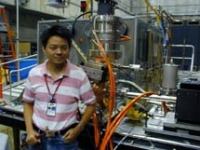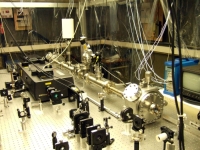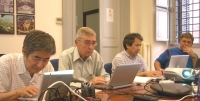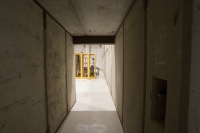 |
|
|
 |
From SLAC Today: ILC Coupler Activities
at SLAC

Postdoc Faya Wang at the coupler coaxial test stand in End Station B. |
While other labs concentrate on developing superconducting cavities for the International Linear Collider (ILC), SLAC is focusing on the technology needed to power them. In addition to klystron, modulator and radio frequency (RF) distribution development, this effort includes a coupler program. A coupler is basically a coaxial transmission line that connects normal-conducting, air-filled, room-temperature waveguides to each superconducting, evacuated, super-cold accelerator cavity. The couplers are complex devices due to the various requirements imposed on them; they must convert the RF to a coaxial mode, transmit high power (~300 kW), be mechanically flexible for cool-down of one end to 2K (-271° Celsius), have a moveable center conductor, have two windows for redundant vacuum isolation, and be as particulate free as the extremely clean cavities.
Read more...
-- Christopher Nantista |
 |
|
|
 |
|
 |
The power of X rays for the ILC

The cavity manufactured by the LAL laser group which reached a very high enhancement factor. |
Producing intense polarised positrons for the ILC is very challenging. Stability, energy, luminosity are the key words. Parallel to the baseline studies on a helical undulator-based source (see Newsline from 19 October 2006), other groups, like the laser group at LAL (IN2P3/CNRS), Orsay (France), pursue R&D on a Compton positron source. The Orsay team recently measured an unprecedented enhancement factor of the pulsed laser beam inside their Fabry-Perot cavity. They expect bigger factors in a few months.
Read more...
-- Perrine Royole-Degieux |
 |
|
|
 |
From Interactions News Wire
17 July 2007
Gruber Cosmology Prize Awarded to Discoverers of Dark Energy
The 2007 Gruber Cosmology Prize has been awarded jointly to Saul Perlmutter of the Department of Energy's Lawrence Berkeley National Laboratory and the University of California at Berkeley, Brian Schmidt of the Australian National University.
Read more... |
|
From Fermilab Today
16 July 2007
Fermilab goes to ILC School
Although Rob Roser, co-spokesperson of CDF, has a busy schedule, he's taking the time to attend a three-day Fermilab ILC school on July 25-27.
Read more... |
|
From SLAC Today
13 July 2007
Pushing for Higher Gradients
Like a boxer eating calorie-dense foods to get to the top of his weight class before a match, particles pumped up on high acceleration gradients pack more power into every collision.
Read more... |
|
From New Scientist
13 July 2007
Is dark energy lurking in hidden spatial dimensions?
The mysterious cosmic presence called dark energy, which is accelerating the expansion of the universe, might be lurking in hidden dimensions of space. The idea would explain how these dimensions remain stable – a big problem for the unified scheme of physics called string theory.
Read more... |
|
From New Scientist
(subscription required)
11 July 2007
String theory: The fightback
It's the theory everyone loves to hate. Depending on who you ask these days, string theory is either untestable, disconnected from reality or not even science. Right? Not so fast.
Read more... |
|
|
 |
Project Managers join the GDE Executive Committee

EC at work: Kaoru Yokoya, Ewan Paterson, Akira Yamamoto and Nick Walker |
The new GDE Project Managers met face to face with the GDE Executive Committee (EC) for the first time in Rome on 9 and 10 July. As of this meeting, they are part of the EC. Made up of senior members of the GDE, the EC gives me advice on important policy issues and planning. It also shares the responsibility for all major decisions of the GDE. The EC had a very important central guiding role during the reference design, and will continue as the highest-level committee during the engineering design phase that will lead to an Engineering Design Report in about 2010. In a very unusual arrangement, the three Project Managers are now officially members of the EC for all matters outside of EDR project management and at the same time will be reviewed by the EC for the progress of their own work.
Read more...
-- Barry Barish
Director's Corner Archive |
 |
|
|
 |
|
A cryomodule's view...
 ...of the new ILC Test Facility at Fermilab. Construction is well underway, and if cryomodules had eyes, this is what they would see from inside the cave. ...of the new ILC Test Facility at Fermilab. Construction is well underway, and if cryomodules had eyes, this is what they would see from inside the cave.
|
 |
|
|
 |
|
Register for ALCPG07
Registration is now open for ALCPG07, which will take place at Fermilab on 22-26 October.
More information
LCWS/ILC 2007 proceedings
The proceedings for the LCWS/ILC 2007 workshops will be published online and a printed volume will be distributed to each participant. The organisers would like to ask each presenter of a talk to submit a contribution. The length should not exceed 1 page per 3 minutes talk in a plenary session or 1 page per 5 minutes talk in a parallel session. The deadline for submission is 15 September 2007.
Detailed instructions can be found here.
Please send your contribution to lcws07-proceedings@desy.de
arXiv preprints
707.1642
11 July 2007
Polarization aspects in radiative neutralino production
707.1425
10 July 2007
How light can the lightest neutralino be?
707.1245
9 July 2005
CALICE Report to the Calorimeter R&D Review Panel
707.0877
5 July 2007
Signatures of Extra Gauge Bosons in the Littlest Higgs Model with T-parity at Future Colliders
|
|

